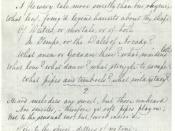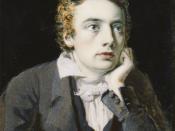The Magnificence of Autumn John Keats, an English poet, was an influential figure of the Romantic Movement. Keats was born in London. In 1816, he became a licensed druggist, but he never practiced the profession. Keats' first published poems appeared in 1816 in the Examiner, a literary periodical edited by the essayist and poet Leigh Hunt. Keats's first book was Poems by John Keats (1817). His second volume, Endymion (1818), was attacked by two of the most influential critical magazines of the time, the Quarterly Review and Blackwood's Magazine. In 1820 Keats contracted tuberculosis. His book Lamia, Isabella, The Eve of St. Agnes, and Other Poems appeared that year. The three title poems, which explore mythical and legendary themes of ancient, medieval, and Renaissance times, are rich in imagery and phrasing. The volume also contains three odes considered among the finest in the English language: "Ode on a Grecian Urn,""Ode on Melancholy," and "Ode to a Nightingale."
In late 1820, under his doctor's orders to seek a warm climate, Keats went to Rome, where he died. Some of his best-known poems were published after his death, including "Eve of St. Mark" (1848). Keats's letters, praised by many critics as among the finest written in English, were published in 1931.
"To Autumn," by John Keats, soothes the heart and eases the mind with its tranquility. Written in iambic pentameter, the rhyme scheme is composed of ababaccac. This poem contains three stanzas of comparison. Through the author's use of versed diction, the poem magnificence is noted.
To begin with, the first stanza serves as an introduction. Line 1 begins by describing "autumn." Then, the author refers to the sun and the role it plays in this season. Lines 3 through 10 show the sun's important role for the advent...


